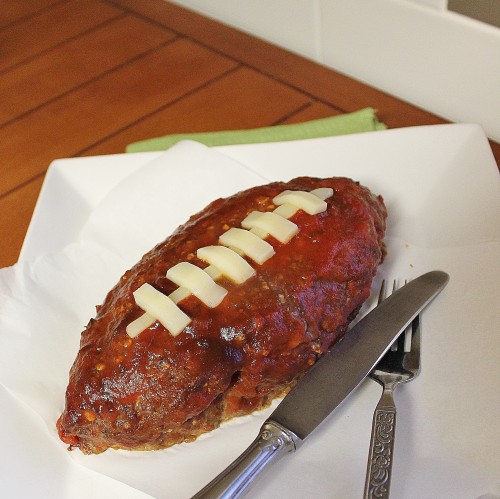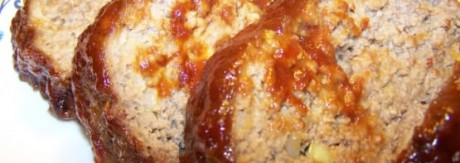Meatloaf – How the Recipe Took Over the World! (The Definitive Guide)

Welcome to Moms Meatloaf Recipe: The Definitive website on everything having to do with The Meatloaf!
Here’s an overview of what we’ll cover in this article:
Introduction —1
The glorious history of the meatloaf—1
Meatloaf around the world—3
So, how do you make meatloaf?—4
What’s the point of having a meatless meatloaf?—5
There’s a singer called Meat Loaf?!6
Introduction
Meatloaf is a dish made from ground or minced meat that is mixed with other ingredients. It is then shaped into a loaf-like form and baked or smoked. Meatloaf is usually made from ground beef, but it can also be made from pork, venison, lamb, veal, poultry and even seafood. The loaf shape can be created either by hand or by putting the meat in a loaf pan.

The glorious history of the meatloaf
The humble meatloaf is a surprisingly old dish. The first reference to a meatloaf is found in the “Apicius,” a collection of Roman recipes that is believed to have been compiled sometime in the late 4th century or early 5th century AD. The recipe called for chopped meat mixed with bread, pine nuts, spices and wine. It looked more like a patty than a loaf, however.
In Europe during the Middle Ages, people ate a meatloaf variant called pastez. It was disc-shaped and consisted of finely diced meat mixed with nuts, fruits and spices. In 17th century France, people dined on loaves made from offal and chopped meat that were preserved by a thick layer of gelatin.
A century later, Pennsylvania Dutch settlers developed scrapple, which became the ancestor of the modern American meatloaf. The Pennsylvania Dutch were and are a frugal people who wanted to get the most from their pigs. After butchering a pig and obtaining all the hams, bacon, sausage, chops and loins it had to offer, the Pennsylvania Dutch would scrape the bones for anything left. They would then mix the scraps with the heart, liver and lungs in a broth. After adding seasonings and cornmeal to the mix they would press the mush into loaves and let them set. They sliced and pan-fried the scrapple before eating it.
American Meatloaf Defined
The American version of the meatloaf developed in the late 19th century after the invention of the meat grinder. Some of the manufacturers sold recipes along with the meat grinders including some for meatloaf.

The meatloaf’s popularity increased during the Depression, and it was during this period that meatloaf gained the status of a comfort food. It was filling and warm as well as cheap and easy to make. Meat grinders could tenderize tough cuts of meat like rump or chuck. The fillers in meatloaf let people stretch small amounts of meat.
Developments in food technology that had first appeared during World War I became more commonplace, and the 1930s saw the rise of canned and processed food. Along with crackers or bread, tapioca, quick-cooking oats, and powdered sauce mixes could serve as fillers in meatloaf. Bouillon, canned soup, Heinz ketchup and mustard were inexpensive and added to the moistness and flavor of a meatloaf.
Innovation – World War II Rationing

Rationing during World War II saw the evolution of the meatless meatloaf. Cookbooks like “Cooking on a Ration” (1943) advised people on how to replace meat with soy flour, rice, beans and nuts.
During the prosperity of the post-war era, fans of the meatloaf wanted to liberate it from its image of privation and austerity. There was therefore a proliferation of recipes that jazzed up the meatloaf. It could be stuffed with mushrooms or baked in a sherry-based sauce. A popular variation was the “frosted meatloaf,” in which mashed potatoes were slathered on top and then cooked until they were golden brown. The meatloaf even became a meat ring with vegetables in the middle.

The 90’s – Gets Zesty
In the 90s, comfort foods, especially those that evoked nostalgia, became trendy, and meatloaf was one of the beneficiaries of that trend. The latest and current cooking trend is giving meatloaf an ethnic flair. One recipe, for example, calls for a “ricotta meatloaf with pecorino sauce.” Another calls for a veal loaf made with wild mushrooms, chorizo and green chile.
Meatloaf Art

“Meatloaf Art” is another trend that’s popular in some circles. It involves shaping the meatloaf into a figure other than the traditional loaf. The cook can, for example, shape the meatloaf into a dinosaur. They can make small meatloafs into footballs and use cheese for the white stitiching. One fellow made a meatloaf rat using olives and radishes for the nose and eyes, spaghetti for the whiskers, sausage for the tails and ears, and chicken feet for the feet.
Meatloaf around the world
Given its long history, it should not be a surprise that variations on the meatloaf theme can be found all over the world. As the Romans conquered much of the known world, they brought their meatloaf recipes with them. Over time, people modified these recipes to make use of local meats, vegetables, and spices.
In Italy, meatloaf is called polpettone, which is derived from polpette, the word for “meatball.” Polpettone is something like a king-sized meatball that is big enough to serve a family, and it can be round or loaf-shaped. It is usually made from several types of ground meat, typically a mix of veal, beef and pork. Herbs and grated cheese are added to the mix, and beaten eggs combined with day-old bread soaked in milk are used to lighten it. Polpettone is often stuffed, and the ingredients for the stuffing can vary. Ingredients for the stuffing can include more ground meat, hard-boiled eggs and different types of cheese.
Kofta is a group of meatball or meatloaf dishes found in the Middle East, the Ballkans and parts of Asia. In their simplest form, they consist of ground meat mixed with onions and spices. Koftas can be made from many different types of meat depending on the country. In India, koftas can be wholly vegetarian and the meat part is replaced with banana, calabash, potato or a type of cheese called paneer.
Bobotie is a popular dish from South Africa, and it is thought to be patterned after an Indonesian dish called “bobotok,” which was meat topped with custard. It was first described in a Dutch cookbook in 1609. Back then, it was usually made from a mixture of pork and mutton; modern bobotie is typically made from lamb or beef. Other common ingredients include dried fruit like raisins or apricots, bread soaked in milk, and curry. It has an egg-based topping garnished with chutneys, bananas and walnuts.
Haslet or Acelet is a pork meatloaf that originated in Lincolnshire, England. The name comes from the Old French word hastilles, which means “entrails.” In addition to ground pork, other ingredients include stale white bread, black pepper, salt and sage. It can be served as a sandwich or with a salad and pickles. The Welsh version is made from pig’s liver, onions and minced potatoes.
Forloren Hare or “Mock Hare” is the Danish version of the meatloaf. It’s made with pork and beef, cream, eggs, bread crumbs and seasonings. Bacon strips are draped lengthwise over it, and the whole loaf is cooked until the bacon has turned brown. It is usually served with gravy.
So, how do you make meatloaf?
There are lots of recipes for meatloaf, and they can range from basic to elaborate. Paula Deen provided the following basic recipe for “The Old-Fashioned Meatloaf”:
- 1 pound of ground beef
- 1 ¼ teaspoons of salt
- 1 ¼ teaspoons of black pepper
- ½ cup of chopped bell pepper
- ½ cup of chopped onion
- 1 lightly beaten egg
- ¼ cup of quick-cooking oats
- 8 ounces of diced tomatoes with juice
The ingredients for the topping include:
- 1/3 cup of ketchup
- 1 tablespoon of prepared mustard
- 2 tablespoons of brown sugar
The directions are similarly simple. Preheat the oven to 375° F. Mix all the meatloaf ingredients thoroughly and shape them into a loaf. Put the meatloaf in a baking dish. Mix the topping ingredients and then spread the topping on the loaf.
Mixing the ingredients and making the loaf will take about 10 minutes. Baking will take about an hour, and the finished product serves four people.
Vegetarian or meatless meatloaf is quite popular in some circles. The challenge lies in making a dish with no meat in it feel and taste like it has meat in it. As with regular meatloaf, there are many recipes, and some use vegetarian burgers as the meat substitute. Other recipes, like the one below, get more creative:
- 1 cup of lentils
- 2 cups of water
- 1 teaspoon of salt
- 1 cup of quick-cooking oats
- 1 small onion, diced
- ¾ cup of grated cheese, which can be American cheese, Swiss cheese, cheddar cheese or Monterey Jack
- 1 egg, beaten
- 4 ½ ounces of tomato sauce or spaghetti sauce
- ½ teaspoon of seasoning salt
- ¼ teaspoon of black pepper
- 1 teaspoon of garlic powder
- 1 teaspoon of dried basil
- 1 teaspoon of dried parsley
Boil the water and salt in a saucepan. Add the lentils and cover the pan, and let the lentils simmer for 25 to 30 minutes until the lentils are soft and most of the water has evaporated. Then drain and partially mash the lentils and put them in a mixing bowl to cool.
Stir in the cheese, oats and onion until thoroughly mixed. Add the egg, sauce, salt, pepper, basil, and garlic powder and mix thoroughly. Grease a loaf pan and spoon the mixture into it.
Bake the meatloaf at 350° F for 30 to 45 minutes until the top of the loaf is golden-brown, firm and dry. Let it cool for about 10 minutes and then serve. It makes four to six servings.
What’s the point of having a meatless meatloaf?
The vegetarian meatloaf is, believe it or not, better for the environment. Raising livestock takes a lot more land, water and energy than raising crops does. In fact, raising livestock uses more land than any other industry. A staggering 30 percent of ice-free land, arable or otherwise, goes to raising livestock, and 26 percent of that land is used as pastures for animals to graze. About a third of arable land is used to raise food for livestock. About 85 percent of the freshwater used in the US goes to agricultural irrigation, and it takes 100 times as much water to produce a pound of meat as it does to produce a pound of grain.
Meat is less efficient and feeds fewer people than crops do, simply because there’s an extra step involved in producing it. Eating vegetables or fruits involves planting a crop and eating the results. Eating meat involves raising crops to feed the animals and then eating the animals. According to some researchers, the land used to raise food for animals could be used to raise food for over four billion people.
Beef production is especially bad for the environment. In 2014, the journal “Proceedings of the National Academy of Sciences” published a study describing the problems associated with raising beef cattle, beginning with the fact they produce five times the amount of greenhouse gas emissions as pork, poultry, eggs and dairy combined. Similarly, beef cattle need 28 times as much land and 11 times as much water as the other categories put together.
The researchers used data covering from the US Department of Agriculture (USDA) covering the years from 2000 to 2010. They used the data to calculate the resources needed to produce the feed for all livestock. They also calculated how much feed a given animal would need to eat in order to gain a kilogram of weight. The researchers then calculated the amount of greenhouse gas emissions produced by raising food crops and by animals’ digestion ad manure.
Cows are ruminants and can eat a wide variety of plants, but they have a low “energy conversion from what they eat.” In other words, it takes a lot of cattle feed to get a pound of meat from a beef cow. According to the Stanford University, it takes eight pounds of grain to produce one pound of cow – and that includes the inedible parts like the bones. In fact, only 40 percent of a cow is edible. It therefore takes 20 pounds of grain to produce of pound of beef. By contrast, it takes 7.3 pounds of feed to produce one pound of pork and 4.5 pounds of feed to produce one pound of chicken.
Given all that, eating meat, especially beef is bad for the environment. The meatless meatloaf is the more environmentally friendly option.
There’s a singer called Meat Loaf?!
Yes, there is. His real name is Marvin Lee Aday, and he was born in Dallas, Texas in 1947. It’s not clear where he picked up the nickname, at least partly because he has told so many stories about it. It is known that he has had a weight problem his whole life, and some of the stories reference that. In one tale, his football coach called him “Meat Loaf” because of his girth.
In any case, he began performing in 1967, as a member of a band called “Meat Loaf Soul.” He also acted and performed in the musical “Hair.” Some years later, he performed in “Rocky Horror Picture Show” and played Eddie in the 1975 movie that starred Tim Curry and Susan Sarandon.
His most successful album was “Bat Out of Hell,” a rock opera that came out in 1977. The best known songs form that album were “Paradise by the Dashboard Light” and “Two Out of Three Ain’t Bad.” He struggled during with drug and money problems during the late 70s and early 80s, but he continued to sing and tour. In 1993, he enjoyed a comeback with “Bat Out of Hell II,” which sold 15 million albums. He also appeared in movies like “Wayne’s World” (1992) and “Fight Club” (1999).
Meat Loaf still tours and sings, and his next album, “Brave and Crazy,” is expected to come out in 2016.
https://en.wikipedia.org/wiki/Meatloaf
https://www.cooksillustrated.com/features/8578-a-brief-history-of-meatloaf-and-how-to-make-it-extra-meaty
http://www.theatlantic.com/health/archive/2011/09/from-budget-fare-to-culinary-inspiration-the-history-of-meatloaf/245265/
http://greatfoodfunplaces.com/tag/edible-food-art/https://www.facebook.com/Meatloaf-art-Meatloaf-is-the-medium-91463812258/
This rat meatloaf has got to be the most unsavory food item ever
https://en.wikipedia.org/wiki/Bobotie
https://en.wikipedia.org/wiki/Kofta
https://en.wikipedia.org/wiki/Haslet
http://www.saveur.com/article/Recipes/danish-meatloaf
http://www.foodnetwork.com/recipes/paula-deen/old-fashioned-meat-loaf-aka-basic-meatloaf-recipe.html
http://www.food.com/recipe/really-good-vegetarian-meatloaf-really-33921
http://inhabitat.com/infographic-the-true-environmental-cost-of-eating-meat/
http://www.huffingtonpost.com/2014/07/21/beef-environmental-impact_n_5599370.html
http://www.bbc.com/news/science-environment-28409704
https://alumni.stanford.edu/get/page/magazine/article/?article_id=29892
http://www.biography.com/people/meat-loaf-262383
https://www.yahoo.com/music/bp/happy-birthday-meat-loaf-did-name-161218009.html





